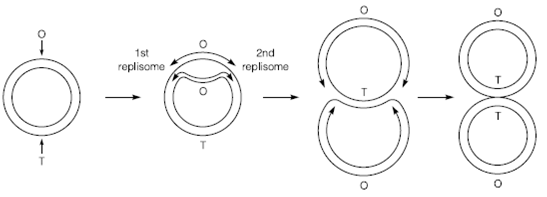Initiation of DNA replication
Our knowledge of Bacterial chromosomal replication is mostly limited to circular chromosomes composed of double-stranded DNA. Rather than being arranged as a simple circle the DNA is supercoiled – twisted and folded in on it. This is to compact the DNA into the very small volume of the cell. The model microorganism, E. coli is only 2 or 3 mm long yet its 4.6 million bp chromosome is about 1 mm in circumference. The number of supercoils in the genome is determined by the competitive action of two winding and unwinding enzymes topoisomerase I and DNA gyrase. The equilibrium among the two is established according to the physiological state of the organism so is influenced through external environmental factors. Additionally gyrase and topoisomerase have to act locally to allow DNA replication to begin. The supercoiled DNA must first be relaxed to allow replication proteins access to the template strands.
Bacterial DNA is always replicated from a single location on the chromosome, known as the origin of replication. This origin is a sequence of around 300 base pairs and here a group of enzymes collectively called the primosome acts in Figure 1. Two primosomes are formed at the origin of replication of circular genomes so DNA replication occurs bidirectionally.

Figure 1. Replication and resolution of circular bacterial genomes. O, ori; T, dif.